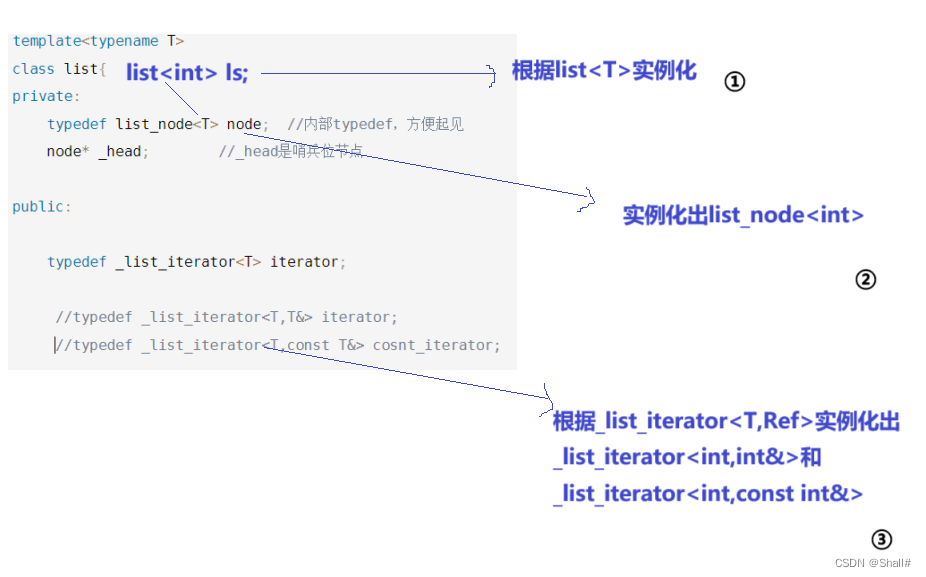List的模拟实现 迭代器
————————————————————
list与vector相比,插入、删除等操作实现的成本非常低,如果在C语言阶段熟悉理解过链表,那么现在实现起来list就显得比较简单,可以说操作层面上比vector更简洁,因为list没有扩容这个繁琐而耗时的操作,就不需要实现reserve函数了,
唯一的难点在于实现链表遍历,当然这里说得不是像C语言下通过原生节点跳转遍历,而是采用迭代器遍历。
STL中所有的容器都采用迭代器++ or --的方式进行访问,对于string和vector来说,迭代器是非常好理解的,得益于string和vector的物理存储空间连续,迭代器可以视作原生指针。
But,对于链表而言,每一个节点的位置都是随机存储的,如果还是使用原生节点去访问,那么势必为出现野指针导致访问权限冲突的问题。故而需要借助类和模板进行封装模拟原生指针的效果。
故而可以 得出:STL中的迭代器可以分为两类
1、原生指针
2、模拟指针效果的对象
因此文章主要谈论list迭代器的模拟实现,具体代码请参考gitee仓库👇
https://gitee.com/chxchenhaixiao/test_c/blob/master/List/List/list.h
首先需要定义节点的结构,数值+前驱指针+后继指针的结构体
template<typename T>
struct list_node{
T _data;
list_node<T>* _next; //带上<T>才是一个类型噢
list_node<T>* _prev;
list_node(const T& val= T())
:_next(nullptr)
,_prev(nullptr)
{
_data=val;
}
}
其次需要实现list的主题框架,我们所实现的是双向带哨兵位循环链表
template<typename T>
class list{
private:
typedef list_node<T> node; //内部typedef,方便起见
node* _head; //_head是哨兵位节点
public:
list(){
_head = new node;
_head->_prev=_head->_next=_head;
}
void push_back(const T& val = x){
node* new_node = new node(x);
new_node->_prev = _head->_prev;
_head->_prev->_next=new_node;
new_node->_next = _head;
_head->_prev=new_node;
}//此处非最优版本,只是为了后续方便测试
}
现在我声明了一个list< int > 类型的 lst 对象,并对它进行尾插操作,使得lst存有整型数据1,2,3,4
现在需要遍历链表,就要去定义迭代器iterator
so,我们开始遍写迭代器
template<typename T>
struct _list_iterator{
typedef list_node<T> node;
typedef _list_iterator<T> self;
node* _node;
_list_iterator(node* val)
:_node(val)
{}
T& operator * (){
return _node->_data;
}
self& operator ++(){
_node=_node->_next;
return *this;
}
self& operator --(){
_node=_node->_prev;
return *this;
}
bool operator !=(const self& val)const{
return _node!=val._node;
}
其实这就是对原生指针的一个封装
接着,我们自然而然会想到,既然已经实现了迭代器,那么我们遍历的时候肯定要通过迭代器类型去访问,则就需要在list类中补充返回迭代器类型的成员函数begin和end
template<typename T>
class list{
private:
typedef list_node<T> node; //内部typedef,方便起见
node* _head; //_head是哨兵位节点
public:
typedef _list_iterator<T> iterator;
//typedef _list_iterator<T,T&> iterator;
//typedef _list_iterator<T,const T&> cosnt_iterator;
list(){
_head = new node;
_head->_prev=_head->_next=_head;
}
iterator begin(){
return iterator(_head->_next);
} //哨兵位下一个节点才是第一个数据
iterator end(){
return iterator(_head);
}
void push_back(const T& val = x);
}
这样就可以实现一个普通list对象的遍历了,
目前还欠缺的是const list对象的遍历实现,因此还需要补充const迭代器,const迭代器的写法可以说是照抄普通迭代器的写法了,但是为了代码变得更为简洁,可以在定义迭代器类型的时候多设置一个模板参数,变成
template<typename T,typename Ref> //Ref指引用
而list中的typedef语句可以更新为
typedef _list_iterator<T,T&> iterator;
typedef _list_iterator<T,const T&> cosnt_iterator;
list类中增设成员函数
const_iterator begin(){
return const_iterator(_head->_next);
}
const_iteraotr end(){
return const_iterator(_head);
}
到这里为止,迭代器基本上已经是大致功能健全了,list的大部分操作借助我们定义的迭代器可以说说非常容易了,这里就不做过多展开。
最后,为了方便读者更好理解,文末献上模板实例化的过程:

